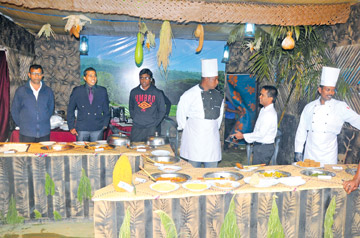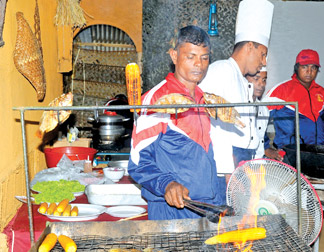Uve hath maluwa, kotchchi sambol and much more
By Dhaneshi Yatawara
Why is the Army involved in a cooking expedition, asked Miri and Amir
Cohen, an Israel couple visiting the 'Hela Viru Rasa Udanaya' in Nuwara
Eliya. Everyone would ask, won't they? In Military life, every aspect
needs to be up to the best possible standard. And definitely the energy
providing food has no excuse.
|

Nutritious delicacies |
Chefs and cooks of the Army play a huge role in keeping the officers
and soldiers energetic, healthy and happy during their highly stressful
demanding jobs. They are the people who keep the blood running in the
veins. They are the people who feed and nourish the brave men of Sri
Lanka Army. And it is part of their duty to find the best nutritious and
tastiest food of the country to serve the men who are ready to serve the
country ultimately with their lives.
Under the command of Army Chief Lieutenant General Daya Ratnayake
these experts search every nook and corner of the island looking for a
Sri Lankan culinary identity.
Embul Thiyal from 'Korali' (a fresh water fish), karawala Karaththa
curry (dried fish wagon curry), kewum (sweet meat) made out of kollu
(horse gram) and many more unusual typical food were prepared by chefs
and cooks of the Army. Through an expedition done across the country the
Sri Lanka Army found different food types unique to those particular
areas. "Different regiments of the Army were given the responsibility to
research on typical food in different areas. A vast number of food items
and techniques were collected by our Army personnel," said Major General
Ubaya Medawala, Commander of the Central Province Security Forces
Headquarters.
 |
| Serving
sizzling hot delicacies |
 |
|
Visitors queueing to taste the food |
 |
| Serving
delectable food |
The 'Rasa Udanaya' had unique and favourite dishes of each and every
province were readily available at every stall. The Rajarata stall
representing the North Central Province brought out the ingredients that
fed the farmer who provided paddy to the entire country. . 'Thalapa' - a
stiff porridge - made out of Kurakkan or finger millet is a favourite
staple food in Rajarata though rice is the staple food in Sri Lanka.
Peasants need economical yet highly nutritious and energetic food that
would keep their bellies full for several hours until the next meal. The
Rajarata stall showcased native rice varieties such as suwandel,
madathawalu and kuruluthuda. These rice varieties are packed not only
with nutrition and fibre but medicinal qualities as well, good for
people with diabetic and hypertension conditions. The sea being at a
distance, the Rajarata folk had to find their protein source from the
fresh water tanks. Rajarata is dotted with fresh water tanks. Fresh
water fish has a unique taste and texture - s. "Basically we lived with
the fishing community to learn the recipes and techniques," said
Corporal Mohan the head chef. The Gajaba Regiment was responsible for
the Rajarata stall and the officer in charge was Lieutenant Colonel
Sujeewa Eragoda.
Along with the staple food varieties the Polonnaruwa or the 'Pulathisi'
stall had crispy salty bites. Officer in Charge Major Sooriya Asmadala
said that many of the vegetables and fresh water fish were used by
villagers as deep fried food. "Ash plantain is a good substitute for
French fries and are without all the artificial ingredients used in it,"
Maj. Asmadala said. The fresh water fish were turned in to tasty bites
topped with a tomato and onion salad. 'The fish needs to be heavily
seasoned," said Head chef Sergeant Ruwan Kumara Rupasinghe. Why is that?
"Fresh water fish have more softer flesh and specially 'goraka' is
compulsory as it stiffens up the flesh. Corn, another widely available
grain in Polonnaruwa was grilled after being dipped in salt water. The
best of the stall was the 'kotchchi' sambol, light green in colour yet a
small bite could give a punch to your taste buds.
Uva and Wellassa had an uncountable number of 'alien' food as the
food patterns of the Veddah community was also of the same area. The
entire range spanned from simple food items to complicated varieties.
"In Uva we searched in 15 different areas for native food," said its
head chef Sergeant Major Kumarasinghe. Uva cuisine was the
responsibility of the Corps of Sri Lanka Electrical and Mechanical
Engineers. They showcased four types of rice - corn rice, a rice out of
water lily seeds ( olu bath), and another two native two rice varieties,
Henatihal and Suwandel. The corn rice has been among the Veddah
community though consumed by few villagers . Well dried corn seeds are
crushed and the coarse remain after sifting is mixed with leema beans
and boiled. A nutritious and healthy food. The vegetable cocktail
typical to the region known as 'Uve hath maluwa' was the main curry of
the stall. A curry with lasia (kohila), sweet potato, pumpkin, ash
plantain, Kathurumurunga and pumpkin flowers, leaves such as mukunuwenna,
sarana, kura thampala, tender leaves of lima beans, pumpkin and chow
chow as well as , winged beans, lima beans and jack fruit seeds.
The Wellassa region is known to be the land of one lakh paddy fields
that fed the entire Sri Lankan Army during king Dutugemunu, says the
legend. People of the area have not only consumed rice from paddy but
have made rice from meneri (common millet or the white millet) as well
as 'thanahal' another smaller seed collected from a plant belonging to
weeds. The wellassa food region was the responsibility of the Sri Lanka
Army's General Servies Corps and in charge officer was Lieutenant
Shirantha and the head chef was Lance Corporal Kumara.
A unique feature was the 'karawala karaththa' curry which is a curry
made out of dried fish, pumpkin, potatoes, lima beans,tomatoes and
spinach.
This is a typical curry made by traditional traders who travelled in
wagons (in sinhala karaththa) from place to place to do their
businesses. This was an easy and nutritious curry the traders could cook
on the way and now has become a part of the wellassa culture. "All dried
fish can not be used. One has to use a variety with more bones.
Otherwise the dried fish parts will melt in to the curry," explained
Lance Corporal Kumara.
From the region of rocks - Ethugalpura - or the area around
Kurunegala had various savoury and sweet dishes which all had a touch of
coconut. The area known for its lush coconut cultivation had a huge
influence on all the food unique to the area. "As coconut is a very
common ingredient in the area we found that it is used to give a twist
to many food items of the area apart from its traditional use as coconut
milk," said head chef rifle soldier Priyantha.
The hill country stall was mostly filled with sweets and snacks. The
jak fruit seeds were made into aromatic curries and snacks. The entire
lot of 'Unduwel' were taken by a customer on the last day. 'Naran kewum',
asmi were favourites among those who visited the stall. "For vegetarians
we found that a special curry made out of jak seeds was famous in this
region," said Major Gamini Wickramage who was the officer in charge. |

